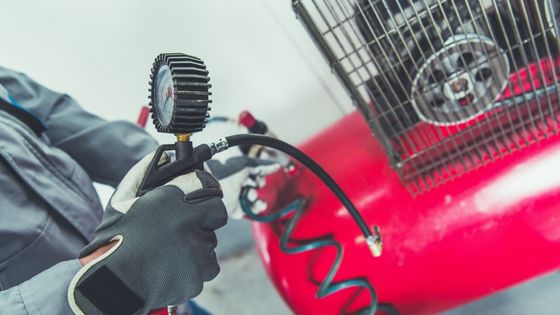No one likes it when their compressor isn’t performing up to par. From fixing a flat tire to powering up your latest DIY project, compressor breakdowns can mean stalled productivity and be downright frustrating. But never fear because compressor maintenance and repair is simple enough that you can often do it yourself.


In this blog post, we will break down exactly what you need to know about compressor parts and repair so that you don’t have to wait on a professional every time something goes wrong. We’ll discuss 7 troubleshooting tips so you can take care of the issue quickly, get back on track with your compressor’s performance, and move on with your day. But before we get there, let’s go to basics.
What is an Air Compressor? How Is It Useful?
An air compressor is a machine designed to convert power into pressurized air, increasing its stored energy. This stored energy can be used in a variety of ways to drive tools, fill tires or perform other mechanical tasks. The most common type of air compressor pumps the air at a certain psi (pounds per square inch) and delivers it through a hose pipe to whatever tool is being used.
Depending on the size of the tank and the CFM (cubic feet per minute) powered by the motor, it can provide an array of services for industrial and automotive use. An air compressor plays an important role when tackling jobs ranging from powering up nail guns for carpentry projects to inflating tires for vehicles. It’s no wonder that this powerful device has become an indispensable part of many shops and garages all over the world.
7 Troubleshooting Tips for Your Air Compressor
Tip#1. Check the Gauge
A faulty gauge is one of the most common causes of an inoperative compressor. Make sure to check for any loose connections or broken wires and inspect the gauge for any cracks or damage. Also, keep an eye out for any bent pins that need to be straightened out before reconnecting.
Tip#2: Check the Pressure Switch
The pressure switch is responsible for turning off your compressor when it reaches its maximum pressure level. If something is wrong with the switch, then it won’t be able to do its job properly and will cause your compressor to run non-stop until it overheats and shuts down. Take a look at the connections and wiring to make sure everything is in working order.
Tip#3. Check the Motor Overload Protector
This device acts as a safety mechanism by shutting down your motor if it becomes too hot or overloaded with a power draw. If this happens, then you will need to wait until it cools down before restarting your machine. To check that your overload protector is working correctly, try resetting it by unplugging and reconnecting the power cord to see if this helps restore power to your unit.
Tip#4. Check the Intake Filter
The intake filter plays an important role in making sure that the air pressure is correctly maintained within the machine, so it’s important to make sure that it is functioning properly. To do this, you’ll need to remove and inspect the filter for any blockage, dirt or debris that could be preventing adequate airflow into your unit. If there are any clogs present, you’ll need to replace the filter in order to ensure that your machine can reach its full potential and maintain optimal pressure levels
Tip#5. Adjust Inlet Pressure Setting
Most machines are equipped with an inlet pressure setting knob near where you connect hoses. It’s important to make sure that this is set according to whatever type of project you are working on. Making adjustments can help ensure optimal performance and maximum air pressure depending on the task at hand – higher projects may require a higher setting than those with lower requirements.
Tip#6. Inspect Hoses & Connectors
Finally, take a look at all of your hoses and connectors, as these could also be causing problems with how well your unit operates (hose leaks, cracked connectors, etc.). Replace any faulty parts immediately so as not to risk further damage being done by having them remain in use while broken/leaking.
Tip#7. Test It Out!
Now that you’ve gone through all these steps – double-check everything once more – plug in your machine & give a test run. You should now have restored full functionality back into your air compressor and you’re ready to tackle whatever projects come next.
















